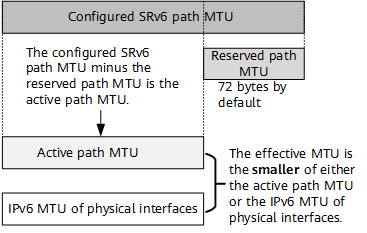Configuring an SRv6 Path MTU
Configure an SRv6 path MTU on the ingress of an SRv6 BE path or SRv6 TE Policy to ensure successful packet forwarding through the path or policy.
Context
Typically, only the source and destination IPv6 nodes parse IPv6 extension headers. Transit nodes forward IPv6 packets without performing packet fragmentation, which is performed only on the source node. If the length of an IPv6 packet is greater than the IPv6 MTU of a device's outbound interface, the device discards the packet and performs path MTU discovery. The impact of the MTU must therefore be considered, because SRv6 uses IPv6 as the forwarding plane.
In addition, if the length of an IPv6 packet is less than the MTU configured for an SRv6 BE path or an SRv6 TE Policy, the bandwidth of the associated link is not fully utilized. Therefore, an appropriate SRv6 path MTU needs to be configured to prevent packet loss and maximize link bandwidth utilization.
An SRv6 path MTU is the total length of a packet encapsulated with both the SRH and IPv6 payload instead of only the IPv6 payload. For details, see Figure 1.
To allow for this additional SRH length in scenarios such as TI-LFA FRR or binding SID, configure a reserved path MTU on the SRv6 ingress. The configured SRv6 path MTU minus the reserved value is called the active path MTU. The smaller of either the active path MTU or the IPv6 MTU of physical interfaces takes effect on SRv6 packets. Figure 2 shows the relationships among the MTUs.
SRv6 path MTU configuration takes effect for packets forwarded through either an SRv6 BE path or an SRv6 TE Policy. You need to configure a proper SRv6 path MTU according to the size of SRv6-encapsulated packets.
Both SRv6 TE Policies and SRv6 BE paths support the global configuration of an SRv6 path MTU and reserved value. For example, if an SRv6 path MTU is set to 1600 bytes and the reserved value is set to 100 bytes globally, the active path MTU is 1500 bytes. In this case, if the IPv6 MTU of physical interfaces is greater than or equal to 1500 bytes, the MTU used by the SRv6 ingress is 1500 bytes. However, if the IPv6 MTU of physical interfaces is less than 1500 bytes, the ingress uses this IPv6 MTU.
SRv6 TE Policies also support the configuration of SRv6 path MTUs on a per segment list basis. An SRv6 path MTU configured for a segment list overrides the global SRv6 path MTU. For example, if an SRv6 path MTU is set to 1600 bytes globally, the SRv6 path MTU of all segment lists is 1600 bytes by default. If an SRv6 path MTU is set to a value other than 1600 bytes for a segment list, this segment list uses the newly configured value. The SRv6 path MTU of the segment list minus the globally configured reserved value is the active path MTU of the segment list. This active path MTU is then compared with the IPv6 MTU of physical interfaces. The smaller value between them is the MTU that the SRv6 ingress actually uses.

